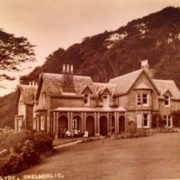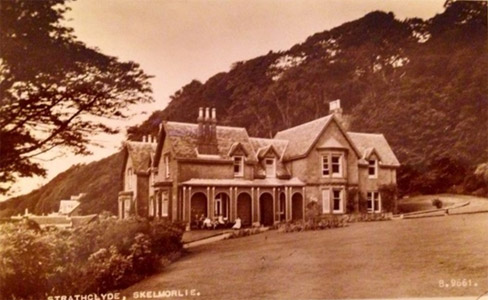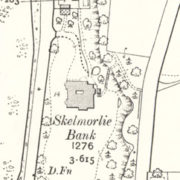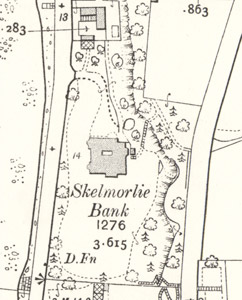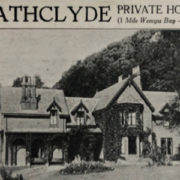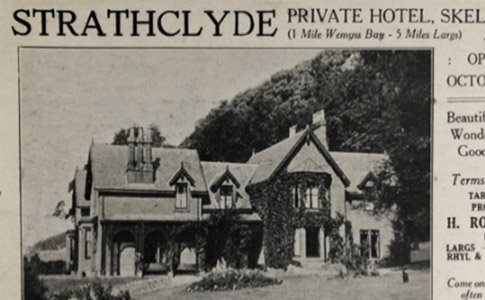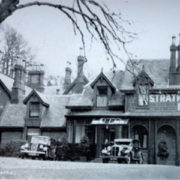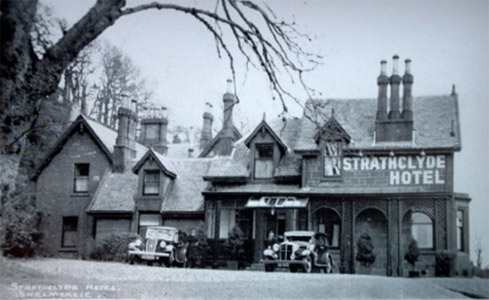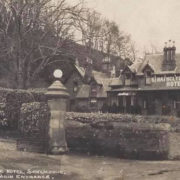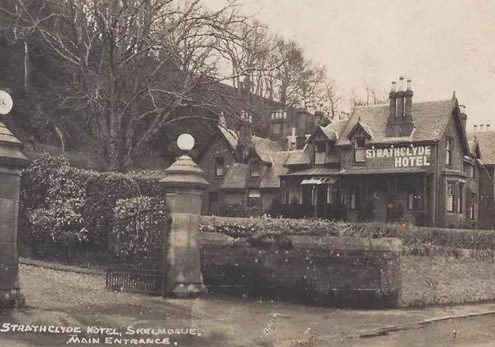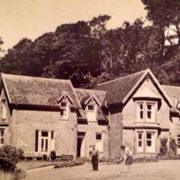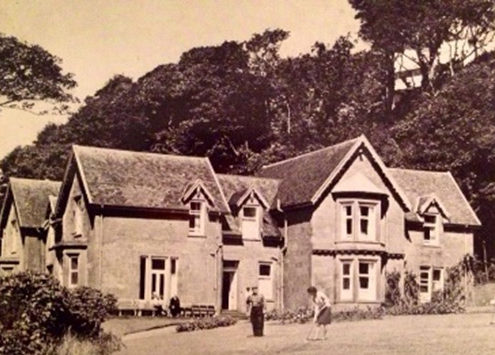Also known as Seabank, Skelmorlie Bank & Ballenoch – 31 Shore Road, Skelmorlie – Now Demolished
Source of Photos:1. Circa 1956 Strathclyde Hotel – Facebook: Skelmorlie & Wemyss Bay in their Heyday. 2. 1910 Ordinance Survey 3. Strathclyde Hotel 1936 – Mrs J Yeomans. 4. – 6. Further pictures of Strathclyde Hotel – Facebook: Skelmorlie & Wemyss Bay in their Heyday.
Research:
-
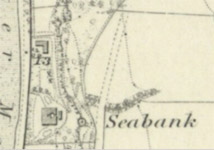
Seabank, Skelmorlie (Strathclyde)
Seabank is one of the first villas to be built on the Shore road in Skelmorlie. Walter Smart in his book “Skelmorlie” talks about Strathclyde (originally Seabank, later Skelmorlie Bank, then Ballenoch) with its cottages existing before 1855” and in the 1856 Ordinance Survey map, Seabank is the only house between Skelmorlie Castle & Halketburn Cottage (at the foot of the Hydro steps).
-
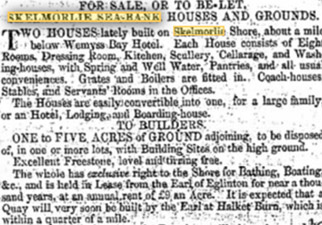
Seabank (laterly Strathclyde), Skelmorlie – Advert 1850
In fact, the first public record of the house was in March 1850, when the Glasgow Herald advertised two houses for sale or let, lately built, at Seabank, Skelmorlie. The advert describes the accommodation in each of the houses (8 rooms, dressing room, kitchen scullery, cellars, etc) and makes the point that the two dwellings are easily converted into one for a large family or as an Hotel, Lodging or Boarding House. The advert also includes a notice to builders that other adjacent plots are available to purchase.
- The next public record appears 5 years later in July 1855; again, Seabank is ‘For Sale’. This time, the two houses, owned by Mrs Rankine, have been joined and are offered as a double villa containing 12 rooms, kitchens, stables, coach house and 2.5 acres of grounds. The advert also highlights building ground for sale, immediately to the north, laid off for 3 villas and extending to 5.25 acres. Note: These plots eventually become Lincluden, Redcliff and Ferniecraig (south to north). Source Glasgow Herald and 1910 survey.
-
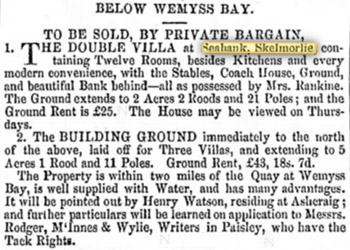
Seabank (laterly Strathclyde), Skelmorlie – Advert 1857
A similar advert appears in Jan 1857, almost word for word, including the reference to Mrs Rankine as owner, but this time the advert is offering the house to Let, rather than to buy. Source: Glasgow Herald.
- We do not know whether the house was let for a period or whether it was immediately sold, but the next recorded residents of Seabank are the Smith family in 1860. “On the 16 Jul, Mrs Wm. Smith (Jnr) gives birth to a daughter at Seabank”. Source Glasgow Herald.
- This is supported by the 1862 county directory that lists Wm. Smith at Seabank and for the 1868 and subsequent directories, W Smith at Skelmorlie Bank. Source: 1862 & 1868 County Directories.
- William Smith (1809 – 1897) was a wealthy cotton manufacturer and mill-owner, who was related to many members of Glasgow’s 19th-century mercantile aristocracy. He and his brother, James, ran two businesses; the Lancefield Spinning Company which they closed in 1876 to concentrate on W, & J. G Smith & Co., a muslin weaving company, based in Dalmarnock. In addition to owning Skelmorlie Bank, “a 12-bedroom holiday home with 5 acres of ground”, William also owned “208 Bath Street, Glasgow, a smart city-centre terrace with ‘three square stories, attics and basement’”. Source: mackintosh-architecture.gla.ac.uk/ catalogue/
- William died in 1897 and Skelmorlie Bank was put on the market soon after. In Feb 1898, the asking price was reduced “Desirable Family Residence, Skelmorlie Bank, Skelmorlie contains 3 public rooms, 12 bed-rooms, servants’ accommodation, etc., with suitable offices detached – all as previously advertised. The grounds extending to fully 5 acres are bounded by the Shore and Terrace Roads, thereby securing perfect privacy and the views in extent and beauty cannot be surpassed. The garden is very large and very productive and there is a conservatory. Greatly reduced upset price £3,000”. Source Glasgow Herald.
- Slightly confusingly, it is reported that William Smith asked John Honeyman & Keppie around 1898 to submit a tender “for unspecified but substantial alterations to Skelmorlie Bank”. The same source (below) concludes that this work was never carried out, as there was no payment recorded in the job-book. Source: Job M165 – mackintosh-architecture.gla.ac.uk/ catalogue/
- The next recorded owner/resident was Abraham Lyle. He is listed in the 1901 county directory under Skelmorlie Bank, but by the 1903 Slater’s directory, the house is listed as Ballenoch. Source: Post Office 1901 County Directory and Slater’s Royal National Directory of Scotland, Skelmorlie ,1903
- It’s not clear when the house changed hands again, but private records, suggest that the next owners were Mr & Mrs James Gilchrist (see photo below) and family. We are told that Mr James Gilchrist worked for Coats (thread manufacturers) and that they had at least 6 children; four boys & two girls. The eldest son was Robert, who worked at Burns Laird & Co (shippers) and was living at Ballenoch when he died in February 1936. Another son, Arthur Gilchrist, (see photo) a 2nd Lieutenant, was killed during WW1. His name appears on the Skelmorlie & Wemyss Bay war memorial. A third son, George, apparently lived in Skelmorlie House for a while, before moving to Dunblane. In 1910, a John Gilchrist of Clark & Co. is listed as living at Ballenoch, Skelmorlie in the Paisley Directory & Advertiser – this is perhaps the fourth son? Of the girls; one, possibly named Eileen, is pictured below in the gardens of Ballenoch in Aug 1912 and moved to Pitlochry around 1920. The other was Mrs Gow Smith who lived at the Redcliffe.
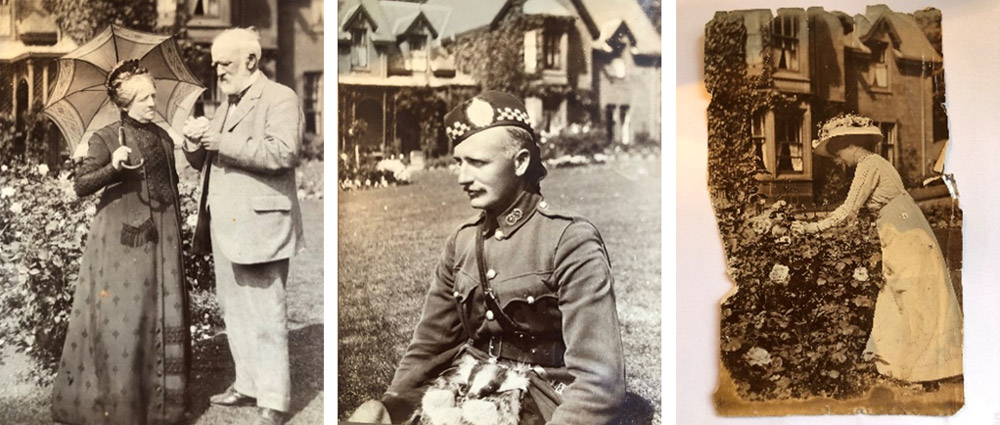
Source: Photographs and notes given to Mrs J Yeomans by Mr James Murray, Pensilva, whose father was a gardener to the Gilchrist family
- Following Robert Gilchrist’s death in February 1936, Ballenoch appears to have been put up for sale. Our next record is a postcard promoting the opening of the Strathclyde Private hotel in October 1936. The proprietor is a H Ross Story. Source: Postcard – Mrs J Yeomans
- After the second world war, Strathcyde was purchased by the South Lanarkshire Miners Association, and mine workers and their families could stay here for a holiday, or miners could come to recuperate from illness. Source: Geocaching.com
- Stratchclyde was eventually demolished and replaced with the current Strathcyde – 56 one- or two-bedroom retirement apartments.

